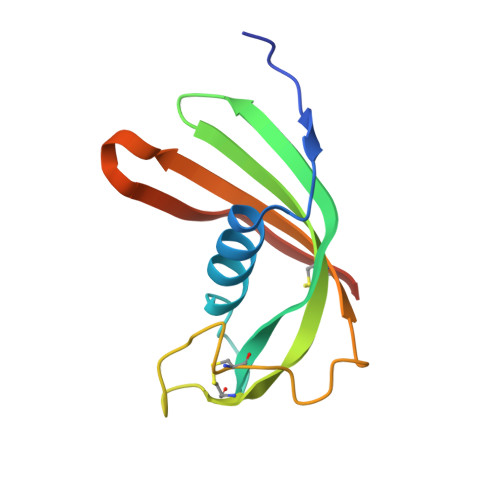Crystal structure and functional characterization of an immunomodulatory salivary cystatin from the soft tick Ornithodoros moubata
Salat, J., Paesen, G.C., Rezacova, P., Kotsyfakis, M., Kovarova, Z., Sanda, M., Majtan, J., Grunclova, L., Horka, H., Andersen, J.F., Brynda, J., Horn, M., Nunn, M.A., Kopacek, P., Kopecky, J., Mares, M.(2010) Biochem J 429: 103-112
- PubMed: 20545626
- DOI: https://doi.org/10.1042/BJ20100280
- Primary Citation of Related Structures:
3L0R - PubMed Abstract:
The saliva of blood-feeding parasites is a rich source of peptidase inhibitors that help to overcome the host's defence during host-parasite interactions. Using proteomic analysis, the cystatin OmC2 was demonstrated in the saliva of the soft tick Ornithodoros moubata, an important disease vector transmitting African swine fever virus and the spirochaete Borrelia duttoni. A structural, biochemical and biological characterization of this peptidase inhibitor was undertaken in the present study. Recombinant OmC2 was screened against a panel of physiologically relevant peptidases and was found to be an effective broad-specificity inhibitor of cysteine cathepsins, including endopeptidases (cathepsins L and S) and exopeptidases (cathepsins B, C and H). The crystal structure of OmC2 was determined at a resolution of 2.45 A (1 A=0.1 nm) and was used to describe the structure-inhibitory activity relationship. The biological impact of OmC2 was demonstrated both in vitro and in vivo. OmC2 affected the function of antigen-presenting mouse dendritic cells by reducing the production of the pro-inflammatory cytokines tumour necrosis factor alpha and interleukin-12, and proliferation of antigen-specific CD4+ T-cells. This suggests that OmC2 may suppress the host's adaptive immune response. Immunization of mice with OmC2 significantly suppressed the survival of O. moubata in infestation experiments. We conclude that OmC2 is a promising target for the development of a novel anti-tick vaccine to control O. moubata populations and combat the spread of associated diseases.
- Institute of Parasitology, Biology Centre of the Academy of Sciences of the Czech Republic, Branisovská 31, 37005 Ceské Budejovice, Czech Republic.
Organizational Affiliation:


















